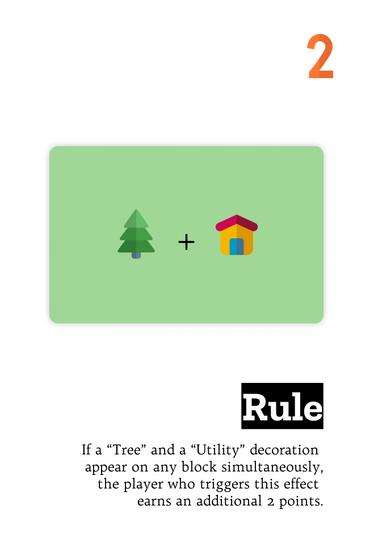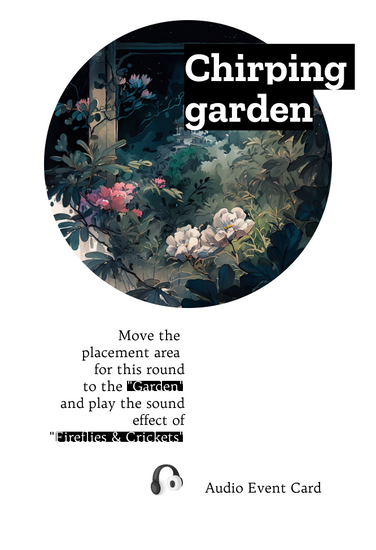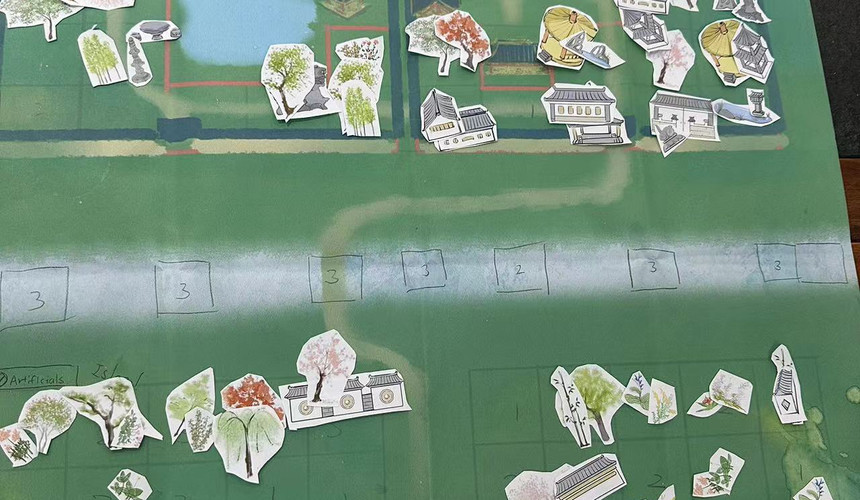Design Document of "Poetic garden"
- FU WEI

- Mar 13, 2023
- 10 min read
Updated: Jun 19, 2023
Designer: Fu Wei
Concept
Story:
You players are the four most talented court garden designers appointed by the emperor. Your last mission: to design a courtyard with the richest and most captivating Chinese aesthetics for the newly appointed Minister of Rites. The one who does the best will be awarded the title of China's Grand Garden Master. With dedicated passion, the soothing sounds of music, and the fragrant aroma of green tea, the journey of aesthetic contemplation begins...
Age:9+
Players: 2-4
Estimated time:30min
Game Structure:
The game board consists of a garden map that is divided into four sections. As the aesthetic adventure proceeds, the garden will begin to take shape and come to life, finally revealing a unique and stunning work of art.
Action:
Players will be able to embellish the garden with various types of decorations, in addition to event cards that introduce relaxing dynamics through activities such as meditation, tea drinking, or listening to the sounds of nature.
Objective:
The objective of the game is to decorate the garden with the decorations while following the map rule. Additionally, players will also need to satisfy the randomly introduced aesthetic rules in order to score more points and reach the final success.
Rationale:
The game itself is a simplified rebuild of behaviors in real life that produce relaxing expericences. It is a gamified mimic of gardening and painting while listening to various relaxing sounds and musics. The game mechanics, such as decoration placement, create a relaxing dynamics that takes relaxation to a fundamental level. With the introduction of matching rule cards during gameplay, the game becomes more unpredictable and enjoyable. The fun and engaging mechanics can put players in a state of flow, further enhancing their relaxation experience to the second level. The appearance of sound effect and action event cards elevates the relaxation experience of all players. These cards use active behaviors and passive sensational intakes to produce the target dynamics of relaxation, making the overall relaxation experience into the third elevated level.
The core mechanics of the game are simple and easy to understand, with the overall art and visual experience, including card design, convey relaxation as well. The game's aesthetic components like the map which features green tones and an ethereal beauty that conveys the serenity and the feeling of relaxation associated with traditional Chinese painting.
Game accessories
Map:
Printed map(50cm*89cm)

Decoration pouch * 1
Spinner*1

Start player marker*1

Scoreboard*1

Player score marker*4
Decoration*185
(Tree: 19*3,Artificial scenery: 13*2,Flower: 24*3,Utility: 15*2)




Matching rule card*8
Event card*28
(Audio event card: 20, Action event card: 8)
Block card *80
(1 score block: 40, 2 score block: 25, 3 score block: 15)
Green tea * players no.
Audio speaker * 1
Play list:
1. Background music: High Mountain and Flowing Water (loop through the whole game)
2. Fireflies & Crickets
3. Rain Sounds
4. Water Sounds
5. The Wind in the Trees
6. Singing Bowl
Setting up
1. Print and place the game map in the center of the table.
2. Put the matching rule card deck and event card deck on the left side of the map.
3. Print and cut the decorations into stick figures and put them in the decoration pouch.
4. Place the spinner on the right side of the map. The pouch containing decorations should be placed below the spinner. The player scoreboard should be placed on the right side of the spinner, with the player marker placed at the zero score position.
5. Place block cards ramdomly: place block cards in the blocks drawn on the board until all the blocks are filled.
6. The player who has recently visited a park becomes the starting player and receives the starting player marker.
Game Process:
1. Spin the spinner and determine the area:
At the beginning of each turn, the starting player will spin the spinner. If the spinner lands on the event card section, the player will draw one event card until it lands on one of the other four sections. If the spinner lands on the main courtyard section, the objective for that turn will be to decorate the main courtyard, and no decorations can be placed in other sections. Once the turn ends, the next player clockwise becomes the starting player and receives the starting player marker.
2.Draw matching rule cards:
The starting player will draw two cards from the matching rule card deck and place it near the matching rule card deck for all players to see, and these cards will determine the special rules that players can follow to earn extra points during that turn. For example, if a player draws a matching rule card that says "Players will earn an additional point for any decoration placed on a block that has red in it," then all players can place decorations with red colors to earn extra points each time they place a decoration.
3.Decoration drawing phase:
At the beginning of the decoration drawing phase, starting with the starting player, players will draw two decorations each in clockwise order from the decoration pouch.
4.Event card phase:
During this phase, only event cards can be played, and players can only have one audio event card active at a time. If a player uses multiple audio event cards, only the effect of the last played audio event card will be activated. There are no limitations for action event cards.
5. Placing cards:
During each turn, players will place decorations within the determined area, starting with the starting player. Players must follow the area restrictions when placing decorations, and they can also follow the rules on the matching rule cards to earn additional points. Decoration placement proceeds in a clockwise order, with each player having the option to place up to four decorations per turn. If a player reaches this limit, they will draw an event card from the event card deck. Players can choose whether or not to place decorations during their turn.If a player chooses not to place decorations, they have limitation of 10 decorations on their decoration in hand and they need to discard their hand untill the condition is met. After all players have placed their decorations, the next player in clockwise order will take their turn.
Score mechanics:
Block scoring: The map blocks have Arabic numerals (1-3) on them, representing the score for decorations placed on that specific block. For example, placing a tree on a block with the number 3 will earn the player 3 points. Each map tile can hold up to 2 decorations. For instance, if a player places a bush on the same block where a tree has already been placed, they will receive an additional 3 points.
Rule Scoring:
Refer to the rules outlined in Game Process 2 to gain extra points based on the matching rule cards drawn this turn.
6. End turn: At the end of their turn, players will calculate the points they have earned and move their score marker on the scoreboard accordingly. Once all players have ended their turn, the matching rule cards will be returned to the matching rule card deck. Repeat the whole process until the win condition is met.
Victory conditions:
(If any of the following conditions are met, the game ends.)
1. Any player reaches 100 points.
2. All the blocks are filled with decorations.
Card and map design rationale:
Map:
The map has four areas: Courtyard, where flowers cannot be placed due to its serious nature in Chinese culture; Garden, where utility cannot be placed as it is designated for leisure and wandering; Forest, where no artificial elements(Utility) or decorations(Artificial scenery) are allowed; and Island, the servants' dormitory where the official prefers no artificial decorations to be placed.
The map's specific decoration placement rules are designed to increase the unpredictability of each turn, enhancing the richness of the gameplay and providing a fresh experience for players. It also adds strategic depth to the game by emphasizing the significance of the event cards, particularly the audio event cards.
Block card:The block card is designed to randomize the scores, adding more replayability and freshness to each game.
Decorations:
There are four types of decorations, Tree, Flower, Utility, Artificial Scenery. Each type's tag and indicator will be placed at the bottom of the decorations.
Event card:
There are two types of event card: Audio event card and action event card, these two types of cards are events that triggered to produce a more relaxing dynamics and a changing gameplay condition. Audio event card: The main purpose of the design is to enhance the overall relaxation level of the game by utilizing various relaxing auditory experiences. Furthermore, to generate more meaningful gameplay, these cards also force the current placement area to jump to the corresponding theme, adding diversity and strategy to the entire system.
These cards utilize psychological studies of sounds that produce the feeling of relaxation. In terms of functionality, they serve the purpose of adding more meaningful play while also adding more relaxing dynamics when players use them.
If an audio event card is activated and another player uses a different audio event card in the next round, the previous activated sound effect will be paused, and the sound effect of the new audio event card will be played.
Action event card: These are behaviors that are proven by scientists that produce the feelings of "relaxation". For example, meditation.
Matching rule cards:
This card mainly documents the rules for earning additional points in this round, and these rule cards will be reset at the beginning of each round. Most of the rules follow the aesthetic concepts of garden design, while others are more playful. These rules are worth 1-3 points, representing the difficulty of matching the related decorations.
The design of matching rule cards is primarily intended to introduce variability to the game, with simple and easy-to-understand rules. The mechanics behind these rules integrates and summarizes the principles of garden design and Chinese garden aesthetics at a comprehensive level. Through specific patterns and interesting rules, the game experience, similar to games such as "Lian Lian Kan" or "Mahjong," creates a chemical reaction that elevates the relaxing gameplay of decorating and creating to a whole new level.
Strategies
Use other players' decoration placement:
Players can use other players' decoration placements to fulfill the requirements of a matching rule card. For example, if the matching rule card for the current turn states that 'If three or more "Flower" type decorations appear on adjacent blocks, the player who triggers this effect will earn an additional 3 points,' thus players can place a flower on an adjacent block if any other player has already placed two flowers on the same block to earn an extra 3 points.
Use event cards flexibly to tilt the balance of victory towards oneself:
When the current hand cannot be placed on the block this turn, event cards can be used flexibly to force the area to switch. Action event cards can also be used to gain an advantage in the current or next turn.
Use card placement mechanism and event cards flexibly to turn disadvantage into advantage:
When the current hand cannot be placed according to the placement rules and does not earn expected points, players can strategically skip the card placement phase. In next turn, players have a greater chance of triggering matching rule cards for additional points with more decoration hand. Alternatively, players can play four cards in a row to earn an extra event card for future benefit.
Optional rule:
Aesthetic proposal:
In games with 3 or more players, the placer can propose that their decoration placement is a creative aesthetic combination in hopes of earning an additional 1-3 points. The placer can explain the reason and aesthetic significance of their placement. If two or more players agree with their viewpoint, the placer can earn the corresponding points.
The significance of designing this system is that the game focuses on "relaxation." Players feel relaxed while using this rule because they can create freely with their decorations. The free and divergent rule aligns with the theme of garden design, which emphasizes creating with the flow of nature. This rule also encompasses subjective perspectives, simulating the relaxing dynamics of a group of talented designers diverging from each other under the same topic. This makes the whole game less serious and aligns with the semantics of "non-serious" expression associated with relaxation. And the open gameplay mechanism also brings greater depth to the gameplay, perfectly integrating the core experience of design - brainstorming.
Testing report:
1.For the first few tests decorations are placed too far apart, they do not create a beautiful scene.
Solution: Increase the maximum decoration limit per block to two, allowing decorations to be placed closer together and creating more beautiful scenes.
2.The decorations at early testing stage seems ungrouped and without any logic to build a conceptual model of how the game should play.
Solution: To make it easier for players to build a conceptual model of the game, I consulted with a professional garden designer and learned about the key elements (trees, buildings, flowers, etc) involved in ancient Chinese garden design. I classified these elements into four categories and combined them with the area restriction mechanics on the game board, which established the foundation of the entire gameplay to a more meaningful experience.
3. Changing only the background music creates some relaxing dynamics, but it is not as enough to make players feel relaxed by actively doing something that produces a relaxed feeling.
Solution: Add action event cards such as "Drinking Tea" and "Meditating" that require active participation from players in behaviors that produce relaxed feelings to further promote relaxation during gameplay.
4.In the early tests, decorations were placed randomly and players were placing whatever they wanted in specific areas, which made the game a bit boring.
Solution: Add restrictions to each section of the map to increase challenges and uncertainty, ultimately creating more meaningful gameplay.
5.Sometimes players' decoration placements are exceptionally beautiful, but there are no additional points given for this.
Solution: Add an Aesthetic Proposal mechanics to the game, where players can create and propose their proudest garden designs to their friends. This mechanics adds liveliness to the game and produces the relaxed dynamics that comes from collaborative brainstorming and design creation among designers.
6.Beautiful decoration placements are judged entirely subjectively through Aesthetic proposal, making the whole game design seems like a less closed and rigorou system.
Solution: This was the most challenging issue of this project. To address it, I consulted with a professional Chinese garden designer and researched garden design concepts and strategies in books. I then interpreted them into matching rule cards from a comprehensive approach. By introducing these matching rule cards with mechanics of changing each turn, they perfectly suit the aesthetic purpose and add more variability and gameplay depth to the entire system. In subsequent testing, the game finally came together as a cohesive and polished product.
7. Players love event card, but it seems too difficult to get one. The game pace also seems a bit slow (1-2h).
Solution: A new event card acquisition mechanism - obtaining an event card after playing four decoration cards from hand. This encourages players to play their cards and increases the rate of event card appearance, leading to more relaxed gameplay as more relaxing events are triggered. Additionally, this speeds up the game pace, addressing the previous issue of the game being too slow.
The final playtest was conducted with friends in a random tea house, accompanied by guzheng music. With the introduction of the new matching rule card system, everyone discovered the joy of the game and entered a state of flow. We were all focused on placing decorations that satisfied the rules while also proposing new ideas to earn exponential points.
The game had an interesting balance. I recall one player reaching 96 points and almost winning, but was penalized by the system for not having the required decorations in a specific area. Other players targeted her, and in the end, she was eliminated by her boyfriend's use of an event card and the matching rule.
I was amazed by the imagination of the players, who used these simple elements to create fascinating Chinese landscape paintings as the game progressed. It made me truly happy and proud as a game designer. The beautiful memories that this simple game brought have strengthened my vision and ideals of making game design and development a lifelong career.
























































Comments